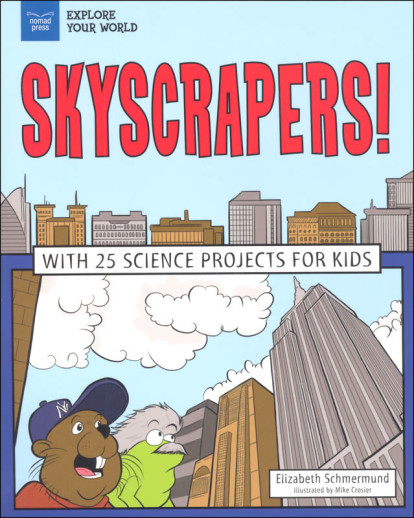We use cookies to make your experience better. To comply with the new e-Privacy directive, we need to ask for your consent to set the cookies. Learn more.
Skyscrapers! (Explore Your World)
Learn good engineering practices, the rationale for tall buildings, and the various unique forces affecting material and design choices. Build a truss, compare wood versus steel, and study compression tubes.
Look up, up, up! How do skyscrapers get so tall? Skyscrapers are amazing feats of engineering that kids (and adults!) find fascinating. How do they get so high? How do they stay standing? Who is involved in designing and building these gravity-defying structures?
In Skyscrapers! With 25 Science Projects for Kids, elementary-aged kids learn about the principles of engineering that are used in building skyscrapers, as well as the history of skyscrapers themselves. Readers also explore the kinds of professionals that contribute to the raising of a skyscraper, from engineers to architects to constructions teams. To answer the burning question on every young engineer's mind-how do skyscrapers stay standing?-readers discover the important designs used to build tall buildings, including the tube frame, thebundled tube frame, and x-bracing. And by following the evolution of skyscraper design, STEAM-focused students learn how structures have become more stable and more complex through the introduction of design elements and new materials.
STEAM projects for kids, including experiments with earthquake-resistant materials, testing the relative strength of different shapes, and discovering the effect of vibration on structures, offer a unique, interactive learning experience, while links to primary sources offer ample opportunity for further student-led exploration. Fun facts, engaging illustrations, timeline, glossary, and resources keep kids wanting to learn more about engineering design.
This series explores STEM concepts and applied sciences. Each book includes 25 projects, averaging a few each chapter. Projects can vary from the simple (like making ocean salt water or forming an arch with your body) to more complicated STEAM projects (wind force; building design; or learning binary code). Adult supervision recommended for these kid-friendly projects. Call-Out sections include explanatory text, vocabulary with definitions, "Did you Know?" sections (with cool "factoids"), Investigate questions, project directions—and even "dad jokes." Throughout each book, periodic QR codes help readers explore additional concepts on external websites. You'll be able to choose from a few activities or match an activity to your child's appropriate grade—or have your budding scientist engage in them all! Includes a theme-focused timeline, essential questions, metric conversions, glossary, resources, and index. See each product description for specific content. Printed in the U.S. Size is 8"x 10". 90 pgs, pb. ~ Ruth
| Product Format: | Paperback |
|---|---|
| Grades: | 2-5 |
| Brand: | Nomad Press |
| ISBN: | 9781619306530 |
| Length in Inches: | 10 |
| Width in Inches: | 8 |
| Height in Inches: | 0.25 |
| Weight in Pounds: | 0.55 |
Be the first to review this item

